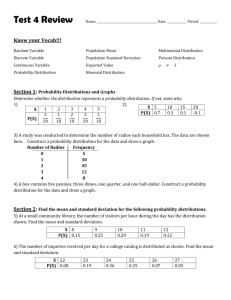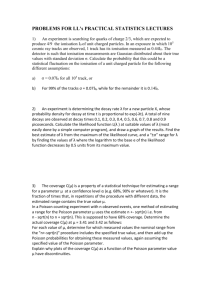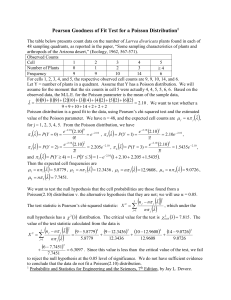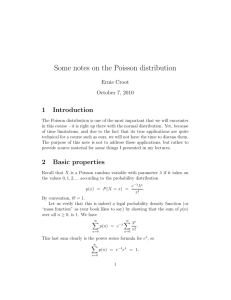STRUTS: Statistical Rules of Thumb
advertisement
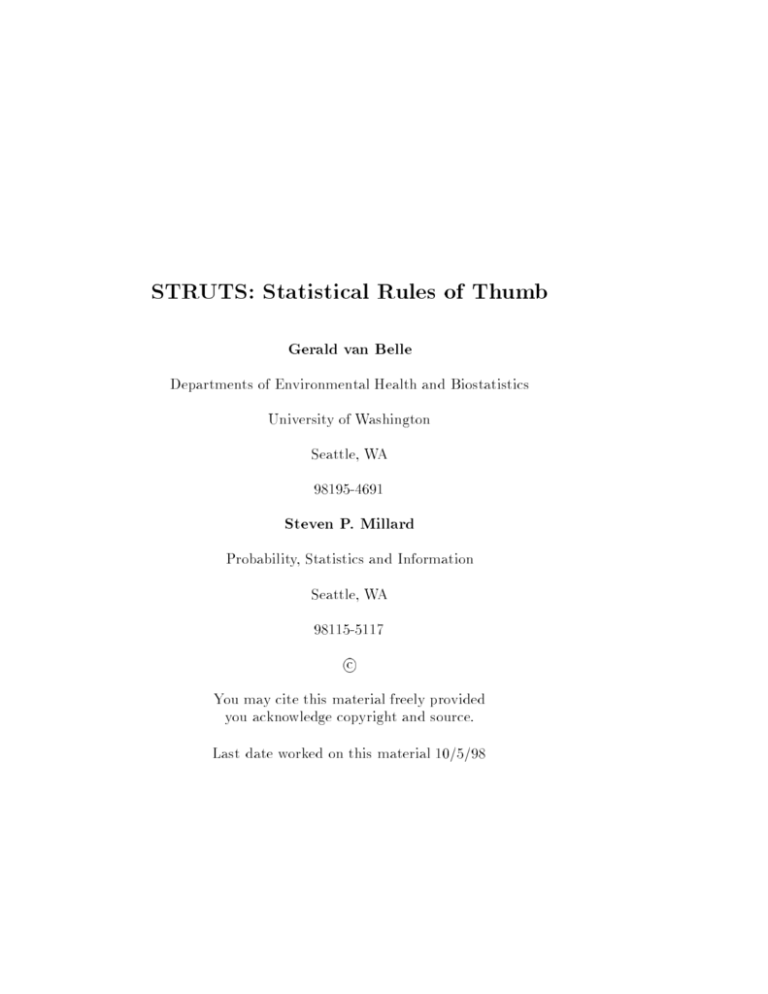
STRUTS: Statistical Rules of Thumb Gerald van Belle Departments of Environmental Health and Biostatistics University of Washington Seattle, WA 98195-4691 Steven P. Millard Probability, Statistics and Information Seattle, WA 98115-5117 c You may cite this material freely provided you acknowledge copyright and source. Last date worked on this material 10/5/98 2 Chapter 2 Sample Size 2.1 The Basic Formula Introduction The rst question faced by a statistical consultant, and frequently the last, is, "How many subjects (animals, units) do I need?" This usually results in exploring the size of the treatment eects the researcher has in mind and the variability of the observational units. Researchers are usually less interested in questions of Type I error, Type II error, and one-sided versus two-sided alternatives. You will not go far astray if you start with the basic sample size formula for two groups, with a two-sided alternative, normal distribution with variances homogeneous. Rule of Thumb The basic formula is: n= where, 16 2 = 1 , 2 is the treatment dierence to be detected in units of the standard deviation. Illustration If the standardized distance is expected to be 0.5 then 16=0:52 = 64 subjects per treatment will be needed. If the study requires only one group then a total of 32 subjects will be needed. 3 4 CHAPTER 2. SAMPLE SIZE Derivation For = 0:05, = 0:20 the values of z1,=2 + z1, are 1.96 and 0.84 respectively and 2(z1,=2 + z1, )2 = 15:68 which can be rounded up to 16. So a quick rule of thumb for sample size calculations is: 16 n = 2: Discussion and Extensions This formula is convenient to memorize. The key is to think in terms of standardized units of . The multiplier can be calculated for other values of Type I and Type II error. In addition, for a given sample size the detectable dierence can be calculated. 2.2 Sample Size and Coecient of Variation Introduction Consider the answer to the following question posed in a consulting session, "What kind of treatment eect are you anticipating?" "Oh, I'm looking for a 20% change in the mean." "Mm, and how much variability is there in your observations?" "About 30%" How are we going to address this question? It turns out, fortuitously, that the question can be answered. Rule of Thumb The sample size formula becomes: 8(CV )2 [1 + (1 , P C )2]: n= (P C )2 where PC is the proportionate change in means (P C = (1 , 2 )=1) and CV is the coecient of variation (CV = 1 =1 = 2=2). Illustration For the situation described in the consulting session the sample size becomes, 8(0:302) [1 + (1 , 0:20)2]: n= (0:20)2 = 29:52 ' 30 and the researcher will need to aim for about 30 subjects per group. If the treatment is to be compared with a standard, that is, only one group is needed then the sample size required will be 15. 2.3. SAMPLE SIZE CONFIDENCE INTERVAL WIDTH 5 Derivation Since the coecient of variation is assumed to be constant this implies that the variances of the two populations are not the same and the variance 2 in the sample size formula is replaced by the average of the two population variances: (12 + 22 )=2. Replacing i by iCV for i = 1; 2 and simplifying the algebra leads to the equation above. Discussion and Extensions Sometimes the researcher will not have any idea of the variability inherent in the system. For biological variables a variability on the order of 35% is not uncommon and you will be able to begin the discussion by assuming a sample size formula of: 1 2 n' (P C )2 [1 + (1 , P C ) ]: References For additional discussion see van Belle and Martin (1993). 2.3 Sample Size Condence Interval Width Introduction Frequently the question is asked to calculate a sample size for a xed condence interval width. We consider two situations where the condence in the original scale is w and is w = w= in units of the standard deviation Rule of Thumb For w and w as dened above the sample size formulae are: and, Illustration n= 16 2 ; n= 16 (w ) 2 : w2 If = 4 and the condence interval width desired is 2 then the required sample size is 64. In terms of standardized units the value for w = 0:5 leading to the same answer. CHAPTER 2. SAMPLE SIZE 6 Derivation The width, w, of a 95% condence interval is, w = 2 1:96 p : n Solving for n and rounding up to 16 leads to the result for w, substituting w = w leads to the result for w . Discussion and Extensions The sample size formula for the condence interval width is identical to the formula for sample sizes comparing two groups. Thus you have to memorize only one formula. If you switch back and forth between these two formulations in a consulting session you must point out that you are moving from two sample to one sample situations. This formulation can also be used for setting up a condence interval on a dierence of two means. You can show that the multiplier changes from 16 to 32. This makes sense because the variance of two independent means is twice the variance of each mean. 2.4 Sample Size and the Poisson Distribution Introduction A rather elegant result for sample size calculations can be derived in the case of Poisson variables. It is based on the square root transformation of Poisson random variables. Rule of Thumb 4p : n= p ( 1 , 2)2 where 1 and 2 are the means of the Poisson distribution. Illustration Suppose two Poisson distributed populations are to be compared. The hypothesized means are 30 p and 36. p Then the number of sampling units per group are required to be 4=( 30 , 36)2 = 14:6 = 15 observations per group. Derivation p Let Yi be Poisson with meanp i for i =1, 2. Then it is known that Yi is approximately normal ( = i ; = 0:5) Using equation (1) the sample size formula for the Poisson case becomes: 2.5. POISSON DISTRIBUTION WITH BACKGROUND RADIATION 7 Discussion and Extensions The sample size formula can be rewritten as: 2 p = : (1 + 2)=2 , 1 2 This is a very interesting result, the denominator is the dierence between the arithmetic and the geometric means of the two Poisson distributions! The denominator is always positive since the arithmetic mean is larger than the geometric mean (xxxx inequality). So n is the number of observations per group that are needed to detect a dierence in Poisson means as specied. Now suppose that the means 1 and 2 are means per unit time (or unit volume) and that the observations are observed for a period of time, T. Then Yi are Poisson with mean i T . Hence the sample size required can be shown to be: 2 p n= : T [(1 + 2 )=2 , 1 2 ] This formula is worth contemplating. By increasing the observation period T we reduce the sample size proportionately, not as the square root! Suppose we choose T so that the number per sample is 1. To achieve that eect we must choose T to be of length: 2 p : T= (1 + 2 )=2 , 1 2 This, again is reasonable since the sum of independent Poisson variables is Poisson. 2.5 Poisson Distribution With Background Radiation Introduction The Poisson distribution is a common model for describing radioactive scenarios. Frequently there is background radiation over and above which a signal is to be detected. It turns out that the higher the background radiation the larger the sample size is needed to detect dierences between two groups. Rule of Thumb Suppose that the background level of radiation is and let 1 and 2 now be the additional radiation over background. Then, Xi is Poisson (( + i )).The rule-of-thumb sample size formula is: 16( + (1 + 2 )=2) : n= (1 , 2 )2 CHAPTER 2. SAMPLE SIZE 8 Illustration Suppose the means of the two populations are 1 and 2 with no background radiation. Then the sampling eort is n = 24. Now assume a background level of 1.5. Then the sample sizes per group become 48. Thus the sample size has doubled with a background radiation halfway between the two means. Derivation The variance of the response in the two populations is estimated by + (1 + 2 )=2. Thi formula is based on the normal approximation to the Poisson distribution. Discussion and Extensions We did not use the square root transformation. The reason is that the background radiation level is more transparently displayed in the original scale and, second, if the square root transformation is used then an expansion in terms in the 0 s produces exactly the formula above. The denominator does not include the background radiation but the numerator does. Since the sample size is proportional to the numerator, increasing levels of background radiation require larger sample sizes to detect the same dierence in radiation levels. When the square root transformation formula is used in the rst example the sample size is 23.3, and in the second example, 47.7. These values are virtually identical to 24 and 48. While the formula is based on the normal approximation to the Poisson distribution the eect of background radiation is very clear. 2.6 Sample Size and the Binomial Distribution Introduction The binomial distribution provides a model for the occurrence of independent Bernoulli trials. The sample size formula in equation (1) can be used for an approximation to the sample size question involving two independent samples. We use the same labels for variables as in the Poisson case. Let Yi be independent binomial random variables with probability of success i, respectively. Assume that equal samples are required. Rule of Thumb n= Illustration 4 (1 , 2)2 : For 1 = 0:5 and 2 = 0:7 the required sample size per group is n = 100. 2.7. SAMPLE SIZE AND PRECISION Derivation where, p 9 = 1 , 2 ; = 1=2[1(1 , 1) + 2(1 , 2)]: An upper limit on the required sample size is obtained at the maximum values of i which occurs at i = 1=2 for i = 1; 2. For these values = 1=2 and the sample size formula becomes as above. Discussion and Extensions Some care should be taken with this approximation. It is reasonably good for values of n that come out between 10 and 100. For larger (or smaller) resulting sample sizes using this approximation, more exact formulae should be used. For more extreme values use tables of exact values given by Haseman (1978) or use more exact formulae (see Fisher and van Belle, 1993). Note that the tables by Haseman are for one-tailed tests of the hypotheses. References Haseman (1978) contains tables for \exact" sample sizes based on the hypergeometric distribution. See also Fisher and van Belle (1993) 2.7 Sample Size and Precision Introduction In some cases it may be useful to have unequal sample sizes. For example, in epidemiological studies in may not be possible to get more cases but more controls are available. Suppose n subjects are required per group but only n1 are available for one of the groups where we assume that n1 < n. We desire to know the number of subject, kn1 required in the second group in order to obtain the same precision as with n in each group. Rule of Thumb The required value of k is, Illustration k= n (2n1 , n) : Suppose that sample size calculations indicate that n = 16 cases and controls are needed in a case-control study. However, only 12 cases are available. How many controls will be needed to obtain the same precision? The answer is CHAPTER 2. SAMPLE SIZE 10 k = 16=8 = 2 so that 24 controls will be needed to obtain the same precision as with 16 cases and controls. Derivation For two independent samples of size n, the variance of the estimate of dierence (assuming equal variances) is proportional to, 1 + 1: n n Given a sample size n1 < n available for the rst sample and a sample size kn for the second sample, then equating the variances for the two designs, 1+1= 1 + 1 ; n n n1 kn1 and solving for k produces the result. Discussion and Extensions This approach can be generalized to situations where the variances are not equal. The derivations are simplest when one variance is xed and the second variance is considered a multiple of the rst variance (analogous to the sample size calculation). Now consider two designs, one with n observations in each group and the other with n and kn observations in each group. The relative precision of these two designs is, s SEk 1 1+ 1 ; = SE1 2 k where SEk and SE1 are the standard errors of the designs with kn and n subjects in the two groups respectively. For k = 1 we are back to the usual two-samplepsituation with equal sample size. If we make k = 1 the relative precision is 0:5 = 0:71. Hence, the best we can do is to decrease the standard error of the dierence by 29%. For k = 4 we are already at 0:79 so that from the point of view of precision there is no reason to go beyond four or ve more subjects in the second group than the rst group. This will come close to the maximum possible precision in each group. 2.8 Sample Size and Cost Introduction In some two sample situations the cost per observation is not equal and the challenge then is to choose the sample sizes in such a way so as to minimize 2.8. SAMPLE SIZE AND COST 11 cost and maximize precision, or minimize the standard error of the dierence (or, equivalently, minimize the variance of the dierence). Suppose the cost per observation in the rst sample is c1 and in the second sample is c2 . How should the two sample sizes n1 and n2 be chosen? Rule of Thumb The ratio of the two sample size is: n2 = n1 rc 1 c2 : This is known as the square root rule: pick sample sizes inversely proportional to square root of the cost of the observations. If costs are not too dierent then equal sample sizes are suggested (because the square root of the ratio will be closer to 1). Illustration Suppose the cost per observation for the rst sample is 160 and the cost per observation for the second sample is 40. Then the rule of thumb states that you should take twice as many observations in the second group as compared to the rst. To calculate the specic sample sizes, suppose that on an equal sample basis 16 observations are needed. To get equal precision with n1 and 2n1 we solve the same equation as in the previous section to produce 12 and 24 observations, respectively. Derivation The cost, C , of the experiment is: C = c1 n1 + c2 n2; where n1 and n2 the number of observations in the two groups, respectively, and are to be chosen to minimize: 1 + 1 n1 n2 subject to the total cost being C . This is a linear programming problem with solutions: C ; n1 = c + pc c and 1 n2 = 1 2 C : c2 + pc1 c2 When ratios are taken the result follows. CHAPTER 2. SAMPLE SIZE 12 Discussion and Extensions The argument is similar as that in connection with the unequal sample size rule of thumb. 2.9 The Rule of Threes Introduction The rule of threes can be used to address the following type of question, \I am told by my physician that I need a serious operation and have been informed that there has not been a fatal outcome in the twenty operations carried out by the physician. Does this information give me an estimate of the potential post operative mortality?" The answer is \yes!" Rule of Thumb Given no observed events in n trials, a 95% upper bound on the rate of occurrence is, 3: n Illustration Given no observed events in 20 trials a 95% upper bound on the rate of occurrence is 3=20 = 0:15. Hence, with no fatalities in twenty operations the rate could still be as high as 0:15. Derivation Formally, we assume Y is Poisson(). We use n samples. For the Poisson we have the useful property that the sum of independent Poisson variable is also Poisson. Hence in this case, Y1 + Y2 + ::: + Yn is Poisson (n) and the question P of at least one Yi not equal to zero is the probability that the sum, Yi , is greater than zero. We want this probability to be, say, 0.95 so that: X P ( Yi = 0) = e,n = 0:05: Taking logarithms we get: n = ,ln(0:05) = 2:996 = 3 Solving for we get: 3 = : n This is one version of the "rule of threes." 2.9. THE RULE OF THREES 13 Discussion and Extensions We solved the equation n = 3 for . We could have solved it for n as well. To illustrate this derivation, consider the following question, '"The concentration of cryptosporidium in a water source is per liter. How many liters must I take to make sure that I have at least one organism?" The answer is, "Take n = 3= liters to be 95% certain that there is at least one organism in your sample. For an interesting discussion see Hanley and Lippman-Hand (1983). For other applications see Fisher and van Belle (1993). References Fisher, L. and van Belle G. (1993). Biostatistics: A Methodology for the Health Sciences. Wiley and Sons, New York, NY. Hanley, J.A. and Lippman-Hand, A. (1983) If nothing goes wrong, is everything alright? Journal of the American Medical Association, 249: 1743-1745. Haseman, J.K. (1978) Exact sample sizes for the use with the Fisher-Irwin test for 2x2 tables. Biometrics, 34: 106-109. van Belle, G. and Martin D. C. (1993) Sample size as a function of coecient of variation and ratio of means. American Statistician, 47: 165-167. 14 CHAPTER 2. SAMPLE SIZE 2.10 WEB sites In the next few years there will be an explosion of statistical resources available on WEB sites. Here are some that are already available. All of these programs allow you to calculate sample sizes for various designs. 1. Designing clinical trials http://hedwig.mgh.harvard.edu/size.html 2. Martindale's \The Reference Desk: Calculators On-Line" This is a superb resource for all kinds of calculators. If you use this URL you will go directly to the statistical calculators. It will be worth your while to browse all the resources that are available. http://www-sci.lib.uci.edu/HSG/RefCalculators2.html#STAT 3. Power Calculator http://www.stat.ucla.edu/~ jbond/HTMLPOWER/index.html 4. Russ Lenth's power and sample-size page http://www.stat.uiowa.edu/~ rlenth/Power/index.html 5. Power analysis for ANOVA designs http://www.math.yorku.ca/SCS/Demos/power/





